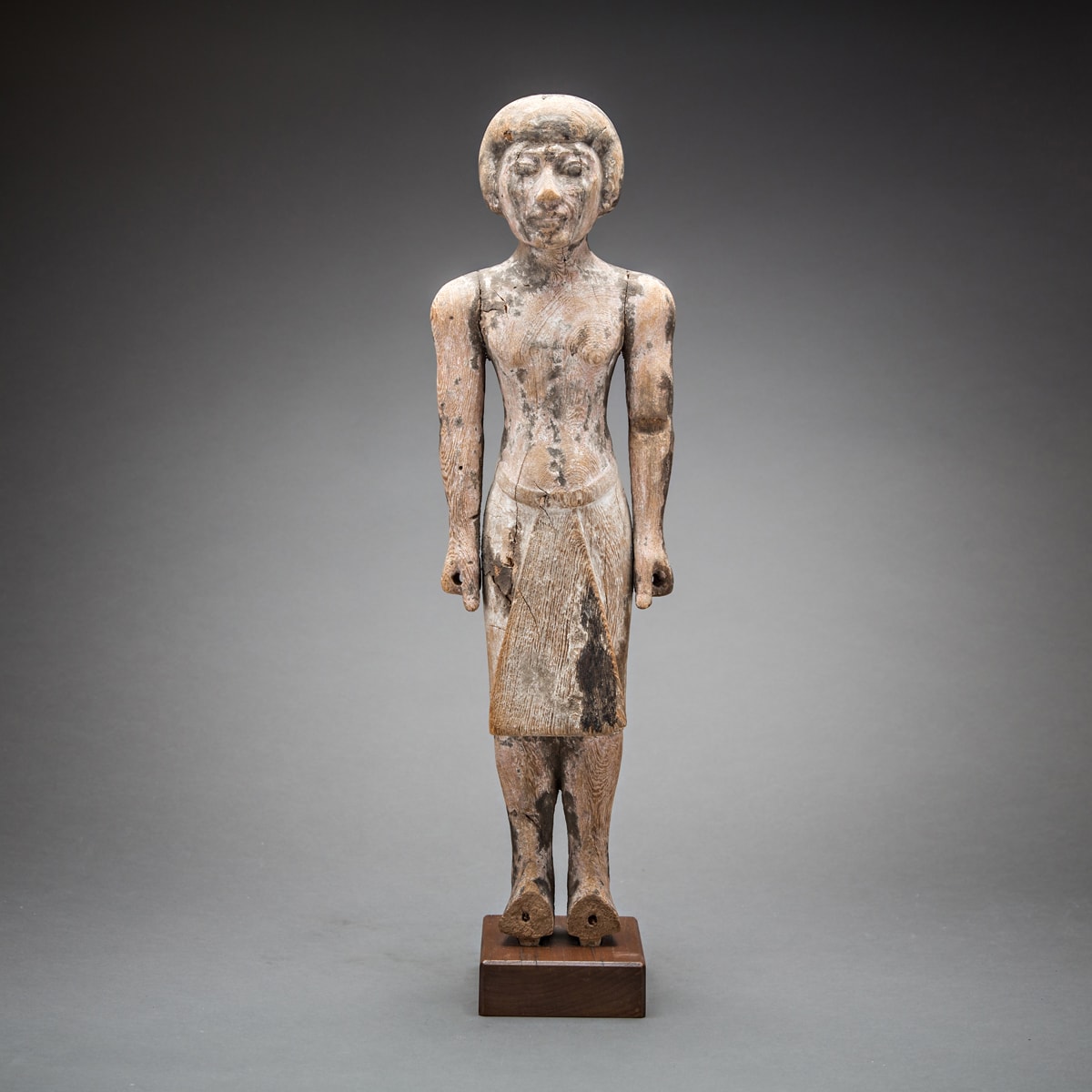New Kingdom male wooden statuette, 1450 BCE - 1070 BCE
Wood
height 50.8 cm
height 20 in
height 20 in
X.0206
Further images
Ancient Egypt, much as modern Egypt today, did not have any great forests to boast of. There were of course some wooded areas in antiquity, and, despite a lack of...
Ancient Egypt, much as modern Egypt today, did not have any great forests to boast of. There were of course some wooded areas in antiquity, and, despite a lack of larger strong timbers, there have flourished numerous active industries of carpentry including boat-making.
Egyptian native timber was mostly of low quality and could only be cut into short planks. Nevertheless, there is no other ancient civilisation from which so many wooden artefacts have survived, as the hyperarid climate of the desert in Egypt is perfect for preserving wood. The dependence on import for a raw material vital to trade and defense was one of the reasons for Egypt's involvement in the politics of Phoenicia.
From the middle of the third millennium onward, and certainly during the turbulent times of the later Bronze Age, Egypt imported significant amounts of cedar wood from Byblos to construct and maintain a considerable fleet. During the occupation of Syria under Thutmose III the Egyptians had the possibility to exploit the mountain forests to the fullest extent.
The building industry did not use much wood, as houses were built of adobe bricks and temples and tombs of rock. Still, some wood was needed for roofs, second storey floors, shutters and doors, and the pillars supporting the ceiling were often trunks of palm trees. Household furniture, musical instruments, board-games and toys were generally made of wood, and often with inlaid decorations and mostly painted. Sculptors had a problem with the local wood as it very seldom yielded logs big enough for life-sized statues. They overcame this by joining a number of logs with wooden dowels. Wooden sculptures from Ancient Egypt are rare, since fine wood was that scarce and expensive. Like many wooden sculptures of the period, the arms of this sculpture were carved separately and pegged on the torso. This male figure stands with his arms held rigidly at his side, fists clenched tightly, and his legs locked together. The traditional hallmarks of Egyptian art are clearly evident: an elongated, slender body, limbs that lack muscular definition, a slightly oversized head with large eyes, and a narrow chin with a slightly smiling mouth. However, the New Kingdom was characterized by an influx of naturalistic tendencies initiated by the religious upheaval (albeit temporary) instituted by Pharaoh Akhetaten. These realistic tendencies can be found on this sculpture in the details of the man’s facial features, specifically his clearly defined cheekbones. The triangular-shaped overhang of his long skirt falls in between his legs. His hair has been carefully groomed into a helmet shape that leaves his ears exposed.
Egyptian native timber was mostly of low quality and could only be cut into short planks. Nevertheless, there is no other ancient civilisation from which so many wooden artefacts have survived, as the hyperarid climate of the desert in Egypt is perfect for preserving wood. The dependence on import for a raw material vital to trade and defense was one of the reasons for Egypt's involvement in the politics of Phoenicia.
From the middle of the third millennium onward, and certainly during the turbulent times of the later Bronze Age, Egypt imported significant amounts of cedar wood from Byblos to construct and maintain a considerable fleet. During the occupation of Syria under Thutmose III the Egyptians had the possibility to exploit the mountain forests to the fullest extent.
The building industry did not use much wood, as houses were built of adobe bricks and temples and tombs of rock. Still, some wood was needed for roofs, second storey floors, shutters and doors, and the pillars supporting the ceiling were often trunks of palm trees. Household furniture, musical instruments, board-games and toys were generally made of wood, and often with inlaid decorations and mostly painted. Sculptors had a problem with the local wood as it very seldom yielded logs big enough for life-sized statues. They overcame this by joining a number of logs with wooden dowels. Wooden sculptures from Ancient Egypt are rare, since fine wood was that scarce and expensive. Like many wooden sculptures of the period, the arms of this sculpture were carved separately and pegged on the torso. This male figure stands with his arms held rigidly at his side, fists clenched tightly, and his legs locked together. The traditional hallmarks of Egyptian art are clearly evident: an elongated, slender body, limbs that lack muscular definition, a slightly oversized head with large eyes, and a narrow chin with a slightly smiling mouth. However, the New Kingdom was characterized by an influx of naturalistic tendencies initiated by the religious upheaval (albeit temporary) instituted by Pharaoh Akhetaten. These realistic tendencies can be found on this sculpture in the details of the man’s facial features, specifically his clearly defined cheekbones. The triangular-shaped overhang of his long skirt falls in between his legs. His hair has been carefully groomed into a helmet shape that leaves his ears exposed.
1
of
38





